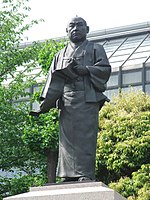Ōishi Yoshio

Ōishi Yoshio (大石 良雄, 24 April 1659 – 20 March 1703) was the chamberlain (
Biography
He served Asano Naganori as the head chamberlain (hittōgarō (筆頭家老)) for the Akō estate, supervising the daily running of the castle and the samurai. Due to the Tokugawa rules which required all the daimyō to spend every other year in Edo (now called Tokyo) the chamberlain was a very important man and the de facto ruler of the estate when the daimyō was away. Having attained this office at a rather young age, he is said to have had the implicit trust of his lord.
When Asano committed
He attempted to get the permission to re-establish the house of Asano of Akō but failed. He then began a careful plot to kill Lord Kira, but to throw off suspicion, first spent time (and money) in the geisha houses of Kyoto. This type of ruse is referred to as hiru andon (昼行灯, daylight lantern) – appearing to be serving no useful purposes, and this term is frequently applied to Ōishi. He carried out his role well – and secretly coordinated the movements of the remaining loyal Asano samurai. Nearly two years passed before the attack was launched.
In January 1703 (by the old
He and the other rōnin were ordered to commit seppuku. Since it was an honourable sentence rather than merely decapitation, everyone accepted this sentence as an honour.
-
Ukiyo-e showing Ōishi signaling an attack by beating a drum. By Tsukioka Yoshitoshi.
-
Painting of Ōishi Yoshio committing seppuku
Legacy
After death, Ōishi became famous as the example of ideal samurai behavior.[2] His ultimate goal of reestablishment of the Akō Asano clan was realized as the Tokugawa shogunate did restore some lands (about 1/10 of the original holdings) to the Asano clan.
In the famous kabuki play Kanadehon Chūshingura, Yoshio (Kuranosuke) is known as Ōboshi Yuranosuke.
-
Statue of Ōishi Yoshio at Sengaku-ji in Tokyo
References
- ISBN 978-1-5026-2459-8.
- ISBN 978-0-19-870662-5.
External links
- The 1941 movie The 47 Ronin features Ōishi Yoshio as the protagonist, see YouTube





